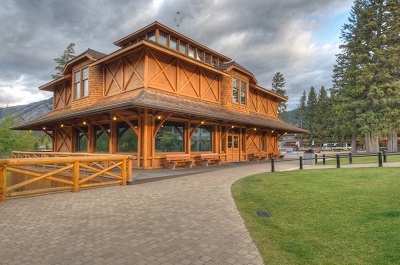Banff Park Museum National Historic Site of Canada
Banff National Park of Canada, Alberta

Exterior Photo
© Parks Canada | Parcs Canada
Address :
91 Banff Avenue, Banff, Banff National Park of Canada, Alberta
Recognition Statute:
Historic Sites and Monuments Act (R.S.C., 1985, c. H-4)
Designation Date:
1985-06-17
Dates:
-
1902 to 1903
(Construction)
Event, Person, Organization:
-
Norman Bethune Sanson
(Person)
Other Name(s):
-
Banff Park Museum
(Designation Name)
Research Report Number:
1980-023, 1985-014
DFRP Number:
15404 00
Plaque(s)
Existing plaque: 91 Banff Avenue, Banff, Alberta
Opened in 1895, the Banff Park Museum was moved into this building in 1903. Its cross-log motif exemplifies an architectural style common in the town at that time. Norman Bethune Sanson, the museum's curator from 1896 to 1932, energetically developed the collections, initially put together by the Geological Survey of Canada. Throughout its early years the museum dealt with natural and human history but by the late 1950s was limited to natural history. While this building was refurbished in 1985, the exhibit reflects museum interpretation current around 1914.
Description of Historic Place
Banff Park Museum National Historic Site is a two-storey, rustic log-faced building set prominently within a landscaped park in the Banff townsite. The double-height interior space displays early botanical and zoological exhibits from Banff National Park in early twentieth-century glass cases.
Heritage Value
Banff Park Museum was designated a National Historic Site in 1985 because:
- this 'museum of museums' developed by Norman Bethune Sanson reflects an early approach to the interpretation of natural history in Canada, and
- its architectural style and detailing is so characteristic of early federal buildings in the Park.
The heritage value of Banff Park Museum resides in its setting, architecture, and in the early (1891-1932) exhibits it houses. Banff Park Museum was designed and built in 1902-03 as a combined museum and Superintendent's Office for Banff National Park by engineer John Stocks. Although the museum remained, other functions in the building changed after 1936. Many of its original exhibits were declared surplus in the 1955-65 period. The building was rehabilitated in the 1980s and 1990s.
Source: Historic Sites and Monuments Board of Canada, June 1985 Minutes; Commemorative Integrity Statement, December 1994.
Character-Defining Elements
Aspects of this site which contribute to its heritage values include: the prominent siting between Banff Avenue and the river; setting within the traditional landscaping of its Central Park grounds; the stepped massing defined by the wide bracketed veranda, hipped roof form of the main block, and the lantern set at the top of the roof; use of the 'rustic' aesthetic with crossed-log motif for exterior detailing, projecting shingled bays on the mezzanine level; provision of natural light with generously sized windows and clerestory; unobstructed interior space created by a cantilevered truss system supporting the second floor and roof; the original functional layout of the interior such as the open mezzanine and staircase; all original interior materials and details (wood finish, trim and detailing); early (1891-1932) artifacts reflecting Victorian and Edwardian museum practice (exhibit collections and cases, curatorial tools, display furniture and equipment, reading room furniture, original documentary material); the arrangement, presentation and layout of exhibits reflecting a 1914 museological approach; its continued public use as a museum of museums; viewplanes to the Bow River, the bridge, its approaches, and to downtown Banff.